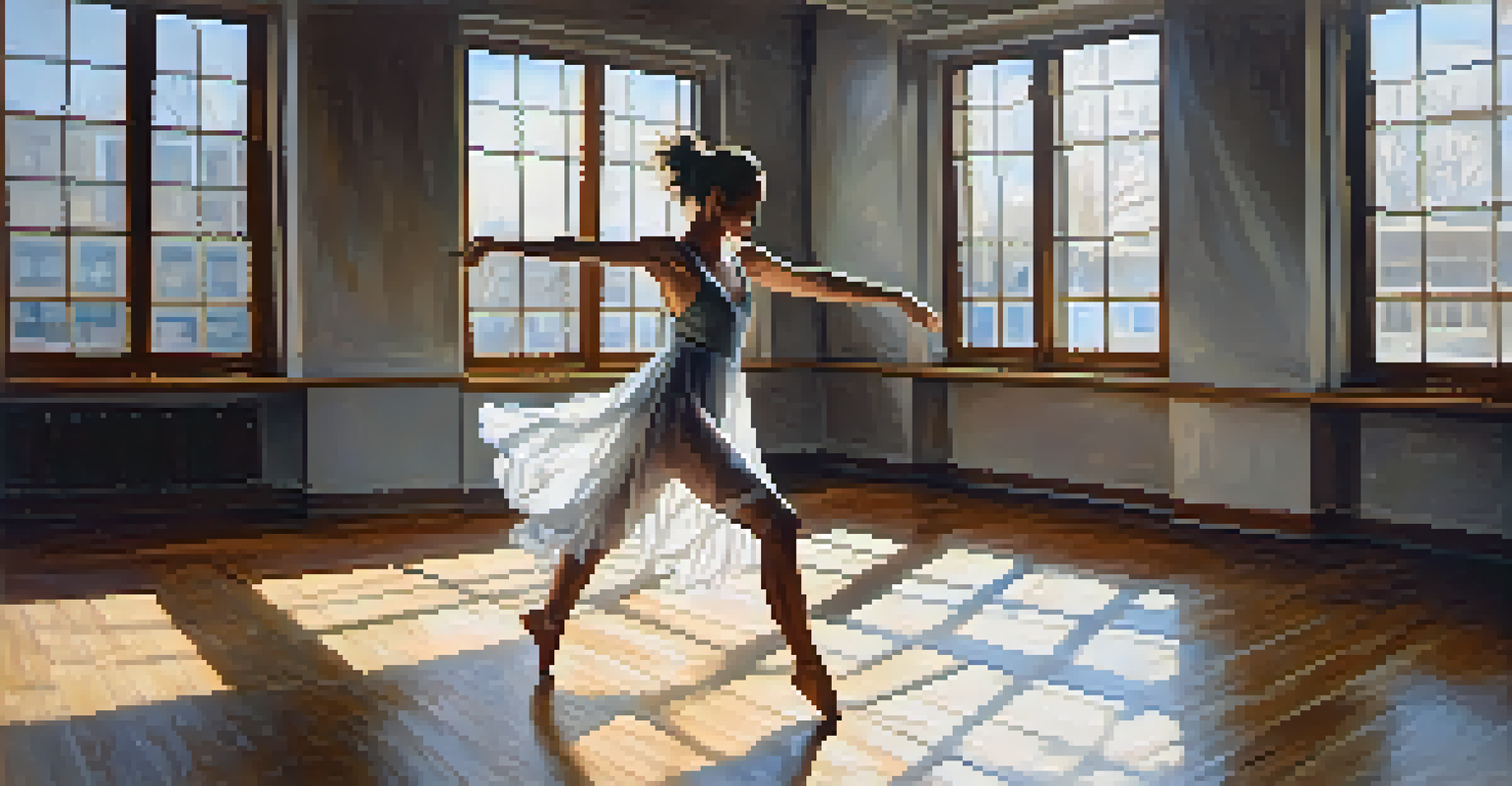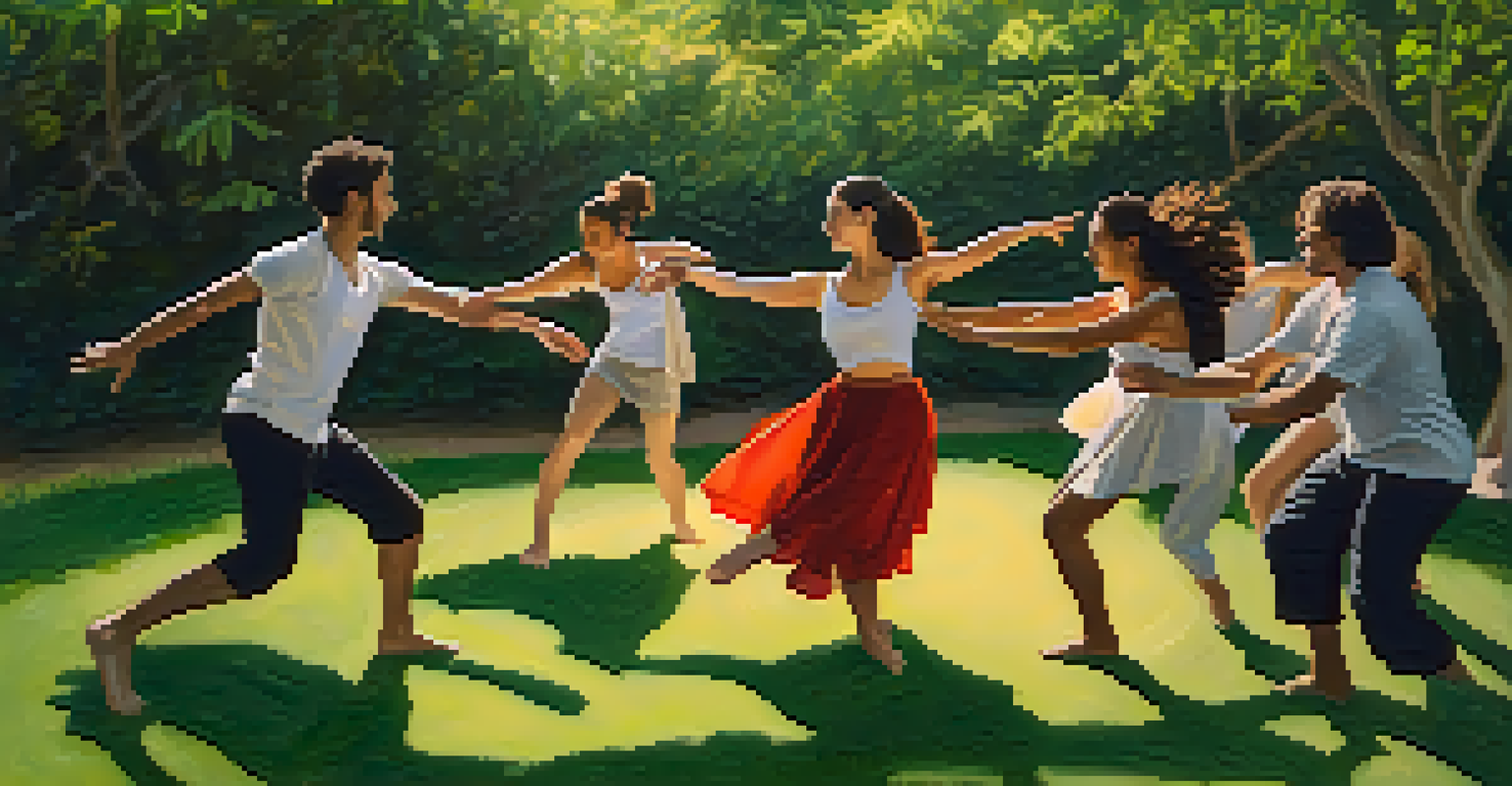The Evolution of Improvisational Dance Techniques

Understanding Improvisational Dance: A Brief Overview
Improvisational dance is a form of spontaneous movement that allows dancers to express themselves without pre-planned choreography. It encourages freedom and creativity, letting the body respond instinctively to music, emotions, or even silence. This dance technique fosters a unique connection between the performer and the audience, making each performance a distinct experience.
Dance is the hidden language of the soul.
Historically, improvisational dance has roots in various cultural practices. From ancient rituals to modern festivals, dance has always been a powerful mode of expression. The beauty of improvisation lies in its ability to adapt and evolve, reflecting the cultural and social changes of its time.
As we delve deeper into the evolution of this art form, we can see how improvisational dance has transformed over the decades, influenced by various artistic movements and the personal styles of dancers. This evolution not only showcases the growth of the dance form but also highlights its enduring relevance in contemporary society.
The Roots: Improvisation in Early Dance Forms
The roots of improvisational dance can be traced back to ancient civilizations, where movement was often intertwined with spiritual and communal practices. For instance, in many indigenous cultures, dance was a way to connect with the divine and express community stories. These early forms of dance were largely improvised, relying on the dancer's instinct and the collective experience of the group.

In the context of Western dance history, the Renaissance period marked a significant shift as dance began to be recognized as an art form. While structured movements emerged, improvisation still played a crucial role in social dances of the time, allowing individuals to express personal flair and creativity within the parameters of certain styles.
Improvisation Fosters Creative Expression
Improvisational dance allows dancers to express themselves spontaneously, creating unique performances that resonate with both themselves and the audience.
As we moved into the 19th century, the influence of ballet introduced a more formalized structure to dance. However, even within classical training, moments of improvisation were often encouraged, especially during performances. This blend of tradition and spontaneity laid the groundwork for the improvisational techniques we see today.
The 20th Century: A Revolution in Dance Improvisation
The 20th century brought a revolutionary wave of change to dance, significantly impacting improvisational techniques. Influential figures like Martha Graham and Merce Cunningham began to challenge the boundaries of traditional dance, introducing concepts of chance and spontaneity. Their work inspired a generation of dancers to explore the creative potential of improvisation in new and exciting ways.
The dance is a poem of which each movement is a word.
Jazz and modern dance also played pivotal roles in the evolution of improvisational techniques during this time. The freedom of jazz music encouraged dancers to break away from rigid choreography, allowing for a more organic and individualized expression. Dance schools and workshops began to emphasize improvisation as a fundamental skill, empowering dancers to trust their instincts.
This era also saw the emergence of contact improvisation, a new dance form that emphasized the physical connection between dancers. Developed by Steve Paxton in the 1970s, this technique encouraged spontaneous movement based on weight-sharing and responsiveness. It became a powerful tool for exploring the interplay of bodies in motion, further expanding the possibilities of improvisational dance.
Cultural Influences on Improvisational Dance Techniques
Throughout its evolution, improvisational dance has been significantly influenced by various cultural practices and traditions. African dance, for instance, emphasizes community and storytelling, often incorporating spontaneous movement that reflects the dancer's emotions. This cultural richness has inspired many contemporary dancers to integrate elements of African dance into their improvisational work.
Similarly, Eastern dance forms, such as Indian classical dance, often include improvisation within their traditional frameworks. Dancers may interpret specific rhythms or moods through spontaneous gestures, showcasing their creativity while respecting cultural roots. This blend highlights the adaptability of improvisational dance across diverse cultures.
Cultural Influences Shape Dance Styles
Various cultural traditions, including African and Eastern dance forms, significantly impact improvisational techniques, enriching the art form with diverse expressions.
As global communication has increased, so too has the exchange of dance techniques. Dancers today draw inspiration from a myriad of cultural styles, allowing improvisation to flourish in exciting new directions. This cross-pollination not only enriches the dance community but also cultivates a deeper understanding of the art form's universal language.
Contemporary Practices: Merging Styles and Techniques
In the contemporary dance scene, improvisational techniques continue to evolve, merging different styles and influences. Today, dancers often blend elements of hip-hop, ballet, and even theater in their improvisational practice, creating a rich tapestry of movement. This fusion allows for unique performances that break the mold of traditional dance.
Workshops and collaborative projects have also become popular, encouraging dancers to explore improvisation in group settings. These environments foster creativity and risk-taking, as participants learn to respond to each other's movements in real-time. This collaborative approach not only enhances individual skills but also builds a sense of community among dancers.
Moreover, technology has played a significant role in shaping contemporary improvisational dance. With the rise of digital platforms, dancers can now share their improvisational work globally, reaching wider audiences and inspiring new generations. This integration of technology not only broadens the scope of improvisation but also encourages innovative approaches to movement.
The Role of Improvisational Dance in Modern Performance
In modern performance art, improvisational dance holds a crucial place, often blurring the lines between structured choreography and spontaneous movement. Many contemporary choreographers now incorporate improvisation as a central element of their work, allowing for a dynamic and ever-changing performance experience. This unpredictability keeps both performers and audiences engaged.
Additionally, improvisational dance has found a home in various artistic collaborations, such as theater and multimedia performances. By combining movement with live music or visual art, dancers can create immersive experiences that resonate on multiple levels. This interdisciplinary approach highlights the versatility of improvisation and its ability to transcend traditional boundaries.
Future Trends Embrace Innovation
The ongoing evolution of improvisational dance is marked by inclusivity, technological advancements, and a commitment to pushing creative boundaries.
The exploration of themes such as identity, social issues, and personal narratives often takes center stage in these performances. Dancers use improvisation as a way to confront and express complex emotions, making their work deeply relatable. This connection between improvisational dance and storytelling reinforces its significance in the modern artistic landscape.
Looking Ahead: The Future of Improvisational Dance
As we look to the future, the evolution of improvisational dance is poised to continue its dynamic trajectory. With the ongoing exploration of new styles and techniques, dancers will likely push the boundaries of what improvisation can be. This forward-thinking mindset encourages innovation and experimentation, ensuring that the art form remains vibrant and relevant.
Moreover, the growing emphasis on inclusivity and accessibility in the dance community is reshaping the landscape. More dancers from diverse backgrounds are sharing their unique perspectives through improvisation, enriching the collective experience. This inclusivity not only broadens the scope of improvisational dance but also enhances its cultural relevance.

Finally, as technology advances, we can expect new tools and platforms to emerge, further influencing the practice of improvisational dance. Whether it’s through virtual reality experiences or interactive performances, the future holds exciting possibilities for this ever-evolving art form. Ultimately, the spirit of improvisation will continue to thrive, inviting dancers to explore, connect, and create in ways we can only begin to imagine.